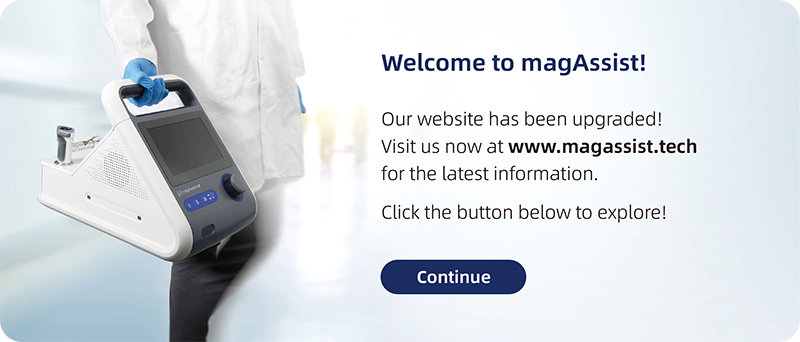Percutaneous Ventricular Assist Device Led by Academician Junbo Ge and Jointly Developed by CCI and magAssist Makes Significant Progress
Introduction
With China’s economic development and aging population, the number of people suffering from cardiovascular diseases is increasing every year. There are now more than 330 million patients with cardiovascular diseases in China, including 11 million with coronary heart disease and 13.7 million with heart failure. Among them, more than 1 million will require circulatory support due to deteriorating heart function.
Ventricular Assist Devices (VADs), also known as artificial hearts, include percutaneous VADs (pVADs), extracorporeal VAD and implantable VAD. pVADs are widely used abroad in cardiology, emergency, ICU and internal medicine departments by virtue of being minimally invasive and convenient to operate. At present, indications approved abroad include circulatory protection during high-risk percutaneous coronary intervention (PCI), treatment of acute attack of chronic heart failure with cardiogenic shock and acute cardiogenic shock with various causes. However, pVADs or similar solutions have not yet appeared on the Chinese market.
The “Jewel in the Crown”, a new horizon in medical-engineering integration
The VAD itself is a medical device with extremely high technological barriers. Also known as the “Jewel in the Crown” of medical devices, VADs face many difficulties and multi-interdisciplinary challenges, including mechatronic systems, precision control algorithms and fluid mechanics, that cover multiple subjects such as biology, medicine and engineering. Aiming to develop the smallest VADs worldwide, the foldable pVADs project faces multi-dimensional barriers such as design, testing and production brought about by device miniaturization. There are only a few teams in the world that could overcome such difficulties. To cope with the different physiological and anatomical characteristics of the Asian population, it is also critical to clarify the key clinical demands throughout the project’s R&D process.
Thus, to ensure the success of VADs on the Chinese market, it is crucial to overcome the extremely high R&D technical barriers and develop products with Chinese characteristics based on domestic clinical application scenarios, medical and nursing operation habits, and patient needs.

Academician Junbo Ge at a pVAD R&D seminar with magAssist
In 2020, in order to solve the huge unmet clinical needs in China, Academician Junbo Ge launched a project with Zhongshan Hospital and magAssist to overcome the difficulties of pVADs. Over the course of a year, the minimally invasive pVAD that they developed was successfully tested in several animal experiments, with its R&D progress taking the leading position in China. Most of the members of this clinical-driven R&D team come from the Center for Cardiovascular Innovations (hereinafter referred as CCI), including Secretary-General Li Shen and first-batch students such as Yizhe Wu, Chenguang Li and Zhiqiang Pei, as well as Yang Chen from the second batch and Yifan Yen from the fifth batch. These members strongly united with the magAssist team in clinical resources and engineering, and engaged in R&D from scratch based on China’s clinical needs.

CCI team members and Dr. Yi Shen, Director of the CCI Animal Experiment Center
This is the first large-scale experiment of the CCI Innovation Engineering and Animal Experiment Center since its launch, as well as a highly difficult experiment with the most complex instruments. Since its founding, CCI has been committed to building a domestic medical device innovation ecosystem. With the core idea of medical-engineering integration based on theory and practical systems, CCI has successfully driven innovations in medical devices, systems and culture. Its first large-scale experiment fully shows the benefits that CCI is bringing to China’s medical device industry and proves the advantages of driving innovation and transformation through a closed loop ecological chain.

CCI Animal Experiment Center and magAssist team
CCI and magAssist have developed the world’s most challenging pVAD from scratch, which has passed pre-clinical evaluation
In the most recent animal experiment, CCI and the magAssist engineering team worked together to verify the system performance and various delivery methods of the smallest pVAD in China. This included multiple stages such as pre-implantation purge preparation, percutaneous intervention, impeller deployment, blood pump positioning, operation process performance monitoring, system recovery and other complete intervention surgery stages. A variety of minimally invasive and flexible intervention methods were used to intervene successfully and achieve the smooth and accurate delivery, positioning and operation of the system.
In the design and optimization of this VAD, computational fluid dynamics (CFD) technology was used to simulate the macro blood pump performance and micro-flow field, and optimize the flow path according to blood compatibility. At present, the prototype has gone through multiple design iterations. In many experiments, the animals were in good condition, proving the excellent blood compatibility of the minimally invasive pVAD.

CCI clinical team during an animal experiment
This is the first pre-clinical evaluation in China to verify the delivery and blood pump performance of pVADs. magAssist’s engineering team will continue to work with CCI to optimize the design in aspects including hydraulic performance, blood compatibility, system reliability, clinically oriented UI interface and human-computer interaction based on human factor engineering. In this way, they will fill the gap in the Chinese market and save more patients with acute or critical heart failure.





